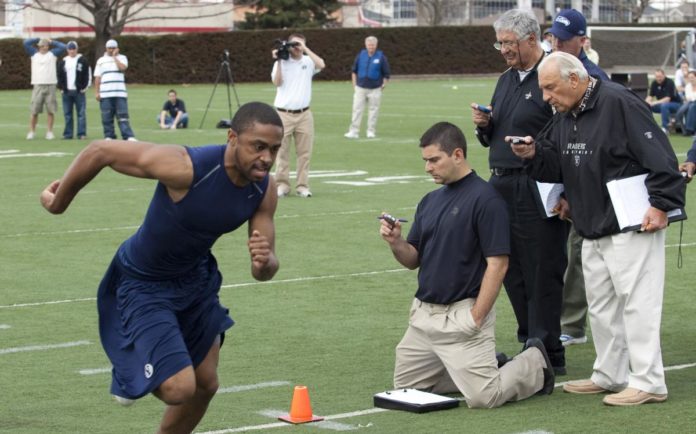Paul Brown asked NFL players in the 1950s to complete a simple task: dash for 40 yards. The physical test provides an easy assessment of a player’s skill, and it’s quantifiable. You can take out a stop watch, make the player run through a piece of tape to finish, and get a fair assessment of talent. Today, cameras capture every nuance of movement. That fundamental scouting tool has persisted because it provides coaches a pure data point to work with, a basis for comparison.
What if that fundamental comparison was possible for playmaking or game knowledge? What if coaches could accurately judge how a player thinks under pressure? Scouts believe they’ve found an answer in VR technology.
Learn More
The statistics are incredible: players can potentially do 2500 reps in 30 minutes. Draft rounds are notoriously brief, but potential players can go through several hundred simulations before teams ever get to that point. Monitors to the side of players show coaches their point of view. In addition to recording the session, staff can figure out almost immediately how a player thinks. Game IQ is becoming one of the most important statistics in drafting. Smarter players make better decisions. Pure athleticism is no longer the decided factor at the professional level.

VR Tech
VR isn’t some mythical piece of technology. Many of the players interviewed have seen it before, either through siblings or from their own experiences. The learning curve is graduallt decreasing, so today’s players are better invested in the technology and see the benefits.
Some even invest in their own setups, which puts pressure on the leagues to follow suit. Today, most professional teams have, or are considering, the infrastructure for VR. That infrastructure isn’t cheap either. Your average home user shells out around $1,000 for a VR setup that is midrange. Teams will invest multiple times more than that on server costs and upkeep. Plus staff to analyze all that data.
It’s a big expense, but utilizing it for scouting helps to improve the value of the system.
Numbers Games
Game IQ embodies many facets of play. Smart play is about more than just figuring out how to single handedly deal with tough situations. The best players understand team cohesiveness and create opportunity. Consider how a quarterback has to react. A QB’s situational awareness is one of the most important factors in a successful play.
VR helps staff review how the QB responds to the snap, where he finds opportunity and what he’s looking for. They can learn to anticipate how he thinks. This is invaluable in the world of scouting, where first hunches can become costly mistakes for underperforming players not ready for professional play.
Another new development is eye tracking. It provides more precise data on what the player is looking at, not simply where his head is tilted, removing even more guesswork.
Competitive Edge
Teams that are willing to invest in VR tend to invest in players too. The new technology is a competitive edge in recruiting as well, especially for higher talent players. That competitive edge won’t just be reflective in a team’s ability to compete. It could be a sticking point in negotiations. If a club has VR and wants to grow talent, late round picks become a lot more competitive.
Additionally, teams gain a better understanding of prospective talent prior to draft rounds. Staff may uncover under-utilized talent.
Final Thoughts
[youtube https://www.youtube.com/watch?v=k1Od7G3CQp8&w=560&h=315]
VR is a game changer, but it’s also affecting how scouts view future talent. The next generation of players will adopt a more academic approach to the game thanks to VR headsets. Game knowledge is becoming a crucial skill, and tomorrow’s athlete will outclass opponents through advanced understanding of game mechanics.
Investment in infrastructure is also crucial for teams to take advantage of this new technology. Consumers need little more than a PC and a headset. Teams would need to house data, gather and utilize footage, and crunch numbers. They require more powerful technology than just the headset.
Scouting is an important part of the game. Scouts determine what the team’s prospects are for the coming years, not just that season. A source of hard data


